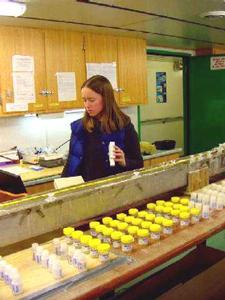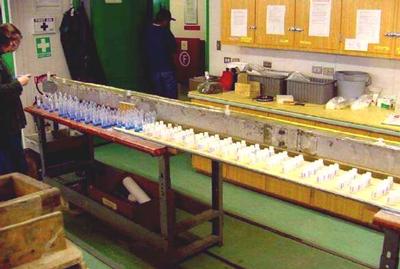
|
|
22 March, 2001
42 24 Longitude
-56 49 Latitude
Katharine
Hi, my name is Katharine. I am a student at Middlebury College in
Vermont. Three years ago at Middlebury, I went to a slide show about
research on the Antarctic Peninsula given by two students and a geology
professor. I was so amazed by the hands on science and the beautiful
pictures of icebergs they saw that I decided I wanted to go there too if I
could. Now, during my senior year at Middlebury, I was able to come down
south to the ice with that same geology professor, Pat Manley, except this
time we went to the opposite side of the continent.
Although the students get to do many different things on board, I am
mainly responsible for helping with the 10-ft long Kasten Cores that come
up on deck. During the entire two months out here we have recovered 29
Kasten Cores and 3 Jumbo Kasten Cores (these are double the length of one
Kasten Core 20 feet long!). As the Kasten Core is coming up from the
bottom of the ocean, I get ready to go outside. In my hard hat and steel
toed boots I go out to the back deck with the tools and someone else who is
also on Kasten Core duty. Since I am on the night shift, it is usually
dark outside and very cold, but sometimes the core happens to come up
during sunrise which is absolutely spectacular! A few times there were
even penguins sitting on nearby icebergs watching us. When the core comes
out of the water, the marine techs lay it on the deck and we open the metal
panels in the top of the rectangular core to find the top of the mud and
get the excess water out.
After carrying the heavy core into the lab and getting it set up for one
of the main scientists to describe and photograph, I get ready to start
measuring the physical properties of the core. First I set up the
Electrical Resistivity (ER) probe to measure the pore water content of the
mud every 2 cm down the core. This unit was actually built by the two
students who went to the Antarctic Peninsula 3 years ago. Observing the
downcore variations produced by this instrument is an effective method for
making correlations between different cores. After this, it is my job to
measure the magnetic susceptibility on the core with a very sensitive
surface-scanning sensor. This is the white probe that you see me using in
the pictures. I have to record the values for every centimeter. Magnetic
susceptibility gives us an idea of how many magnetic parcticles there are in
the sediment, which is indicative of the sediment source (land erosion or
biological activity in the ocean). Along with the ER, we can use these
records to learn more about similarities in past climate change cycles
around Antarctica.
Finally, I take samples from the core to take back to Middlebury to study
the actual water content and pore space between sediment parcticles. To do
this we brought 3200 vials with us but we got so many cores that we ended
up running out of vials. We had to make do with whatever we could find for
the last Jumbo Kasten Core (see picture of vials). It takes a few hundred
vials to take these samples on each core which means I will have a lot of
work to do to process them when I get home! All this sampling is
definitely worth it because of the high quality of the cores we took and
because of the amazing things we have been able to do down here in the
Southern Ocean.
Katharine Burgdorff




Contact the TEA in the field at
.
If you cannot connect through your browser, copy the
TEA's e-mail address in the "To:" line of
your favorite e-mail package.
|
